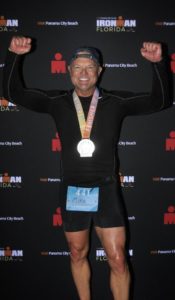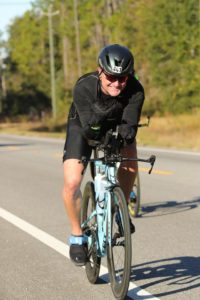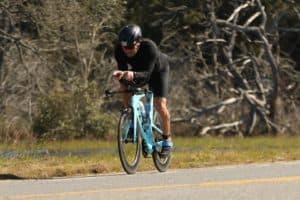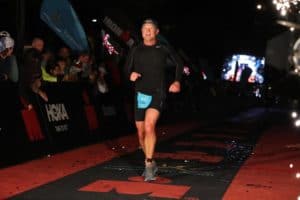As many of you know, I completed another Ironman distance triathlon recently. Triathlon training and competition have been a part of my life for over 35 years, and the Ironman distance is the pinnacle of the sport. The Ironman distance consists of a 2.4-mile swim, followed by a 112-mile bike ride, and ends with a 26.2-mile run. You have 17 hours to finish all three events and there are time cutoffs at various stages of the race. If you miss a time cutoff, you are pulled from the course, and your day is done. I did this same race 10 years ago at the age of 42 and said it would be my last; the amount of training required to complete the ultra-distance races takes a toll over time, and 30 years of training and racing has left my body broken in many ways. This is my tale of two Ironman races – 10 years apart.
Ten years ago, I signed up for Ironman Florida on my phone while in a grocery store. Before the COVID-19 pandemic, most of these races, which admit up to 3500 athletes, would fill up in 5-10 minutes, so you had to be ready to sign up as soon as the race registration opened. At that point in my career, I was having a lot of back and knee issues and thought I would not be able to finish the ultra-distance course, despite completing over 70 shorter-distance races over the prior 25 years. I was no longer able to consistently run the long distances required to prepare, but if I didn’t at least try to finish the IM distance, I would always regret it; it was literally the only thing on my bucket list at the time.
After signing up for that race 10 years ago, I planned out a year of training and slowly built up the endurance base I would need to finish. I took my time, backed off when I needed to, and made it to race day mostly intact. I can still remember everything about that day, including walking up to the race venue that morning before the sun came up, the bright lights and loud music contrasting the darkness, cool temperatures, and the morning mist that made everything cool and damp. I made a point to soak it all in because this day would be a special one and a goal I had dreamed about for over 20 years.

What I didn’t realize until 10 years later is that we had near perfect race conditions that cool November day. Although a little cold in the morning, the water was mostly calm, there was not a lot of wind on the bike, and it never got too hot. Fast forward 10 years later, I would learn a painful lesson about just how easy we had it that day.
Nine years after what was to be my last race, I decided to throw my hat back into the ring and put my mind and body to the test again. I can’t tell you what lead me to make that final decision, but this time it was made sitting at my desk while working after receiving an email notification that the registration would open at noon that day. I remembered how fast these races filled up, so with little time to dwell on it, I signed up as soon as the registration opened, and at that point, I was committed. Registration opens about one year before the race, giving you a long time to prepare. I would start my preparation 2 months later, 10 months before race day.
It’s amazing the difference that 10 years makes. Much of the equipment I had used 10 years earlier had become obsolete, and the amount of new technology available was mind-boggling! I purchased a smart trainer that controlled my bike from an app that my coach would use to download my workouts. I replaced my pedals with new ones equipped with Bluetooth power meters that monitored my output and the pressure I applied in all 360 degrees of the pedaling stroke, all of which was transmitted to the Garmin computer on my bike, giving me real-time output data while training and racing. Triathletes are the ultimate gear heads and all of this equipment provides you with tons of data to analyze and dial in your training and performance!
Another big difference compared to the last go-around is social media. Back then, Facebook was not nearly the behemoth it is today, and Instagram didn’t even exist yet. This time around, there are hundreds of Ironman and triathlon groups, down to the particular race you are planning to do, and even multiple Ironman tattoo groups! They are mostly friendly and informative groups that provide an online community to share your journey, anxiety, and training tips. Yes, there have been a lot of changes to the sport over the years, but the people are mostly the same. Fun-loving, laid-back but OCD types that have a passion for pushing mental and physical limits as a hobby. You will never receive more encouragement from, or be more inspired by, random strangers than you will on an Ironman course! The professional that won that day came back to the finish line to cheer on the thousands of age groupers that finished as much as 8 hours after he did. That says a lot about the personalities that this sport attracts.
My coach planned every workout I would do leading up to the race, adjusting them based on my progression and how much I whined. Like most people training for a race of this distance, I had my ups and downs with injury, fatigue, and life getting in the way, but I made steady progress and by race day was in the best shape of my life. I should have had no trouble hitting my goal of a sub 13-hour Ironman, 40 minutes faster than my prior time 10 years before!
Driving to Panama City Beach two days before race day, I started getting chills despite the warm weather. I was afraid to even say anything out loud, and quietly tried to will away any illness that might be coming my way. Thankfully, it turned out to be only a mild cold, but it did affect my energy and had me constantly worrying if I would continue to get worse leading up to race day. This brings us to the morning of the race…
Mike Tyson has a great quote about plans: “everyone has a plan until they get punched in the mouth.” This would become the most appropriate quote used to describe Ironman Florida 2021.
The weather was kind of miserable leading up to race day, but it didn’t make the conditions any easier to swallow that morning. We woke up to 48-degree temperatures and strong winds out of the northeast. We were all wetsuit clad, except for the one guy in a speedo, but the sand was like walking on frozen concrete, and it was actually more comfortable in the 68-degree water than it was onshore, so I took my time warming up before making my way to the starting chute. From the shore, the water seemed fairly calm as I surveyed the racecourse and the line of huge orange buoys bobbing in the water that seemed to stretch all of the ways to the horizon. From that vantage point, no one could have known that Mother Nature was about to show us that she did not come to cooperate on this day.

These days, they have you self-seed your start position in a starting chute based on what you expect your time to be, and it is on the honor system. They release 5 swimmers every 5 seconds. Leading up to the race, I had completed this distance in under an hour in training, so I went straight to the front and was among the first 20 swimmers to start after the pros. When my group of 5 stepped up to the line, we listened for the countdown from 5, 4, 3, 2, 1… and suddenly, our day had started.
It didn’t take long to realize something was off about the water conditions. As I sighted the first turn buoy, 800 yards offshore, I realized I was drifting to the left more than I should have been and I had to expend a lot of energy to maintain my line. After making that first turn, however, it became very apparent that the current was ripping to the East, making for a very difficult West to East leg as we swam parallel to the shore. After making the final turn back to shore, it was a struggle to stay to the left of the buoys against a current that wanted to force you back to the right. As I 
It wasn’t until after the race that the stories started coming in about just how hard that swim was. Some of the pros said it was the hardest Ironman swim they have ever done, and the rumor was that around 500 athletes were unable to finish the swim, or did not make the cutoff time to be able to continue. We also heard many had to be assisted out of the water because they couldn’t continue. I came out of the water in 1 hour and 21 minutes, a full 20-25 minutes slower than I expected, but that time was good enough for 11th in my age group and 164th overall out of the 2500 or so athletes that started that day.
As I got out of the water for the second time, the arch of my right foot was cramping from the cold water and sand, so I hobbled along with a wave of athletes, most of whom made the turn to head down the beach for their second loop. It was a long jog on ice-cold concrete to the bike transition, but I was in good spirits as I stopped for a quick freshwater shower to wash off the salt and sand before making my way to the bike racks. Leading up to race day, there was a lot of debate and discussion about what to wear after the swim. I typically stay in the same tri-suit throughout the entire race, which I wear under my wetsuit during the swim. The debate today, though, was due to the cold and wind after getting out of the frigid water. I eventually decided to just wear my tri suit bottoms under my wetsuit so my tri top would be dry for the start of the bike. I also wore a long sleeve base layer and full-fingered gloves in anticipation of the conditions on the bike. This was ultimately the right decision as the first 70 miles of the bike were cold and windy, making it difficult to warm up, even while barreling through headwinds up to 17 miles an hour.
Another benefit of being a strong swimmer is that the bike course is not as congested as it is later in the race, and that translates into many saved minutes over the course of 112 miles. I am a strong, but not great, cyclist, so for the most part, the athletes passing me during this portion of the race are really good or elite cyclists, so I typically spend a lot of the bike course in my own rhythm without having to maneuver around a lot of slower cyclists. The athletes that are passing me are usually flying by and in another stratosphere of fitness. You also save time in the aid stations, having only to slow down a little to grab water or food from the many volunteers lining the side of the road. Later in the race, there would be lots of jockeying for positions as the number of cyclists outnumbered the volunteers. You can also end up waiting 10 minutes outside a Port O Let later in the day, whereas the one time I had to stop there was no one else around.
Ironman Florida is mistakenly considered an “easy” Ironman – if there even is such a thing: calm, flat waters followed by a fast, flat bike and run course. The swim on that day proved that “easy” is a relative term, and the fallacy of an “easy”, long, and flat bike course catches up to you when you have spent 3-4 hours in aero position because you don’t have the need to get out of the saddle to climb much. Each Ironman comes with its own unique challenges, and Ironman Florida is no different. I’ve done races on this course in 50-degree windy weather and in humid 95-degree weather, and it is a toss-up as to which of those conditions present the more difficult challenge. In this race, however, you take what the day gives you and adapt as needed to accomplish the ultimate goal, which is to finish.

Like the swim, it didn’t take long for me to realize I was probably not going to hit my goals on the bike. The first 70 miles were met with very strong headwinds and crosswinds. Instead of the 19-20 mile an hour pace I hoped to maintain, it was closer to 15-16 miles an hour. Despite the conditions, everything was going well, until it wasn’t…
Around mile 55 or so, I went through an aid station without taking on more water. I thought I had enough on my bike with the 3 bottles I was carrying, but I didn’t realize that one of them was almost empty. I quickly ran out of fluids over the next 30 minutes, which was right around the time that it started to warm up and we turned into a 15 mile stretch of direct headwinds and rolling hills. I mentally kicked myself over the next 10 miles as my mouth got dry from dehydration and I got a little light-headed. At the turnaround at mile 70, I tried to calculate when the next aid station would appear as I considered stopping at a convenience store to buy some water. You never know what might go wrong at Ironman so, yes, I even bring some cash along just in case. This is the type of mistake that can end your day at Ironman, and I knew I would probably pay for it later, but I continued on to the next aid station and quickly put down a bottle of Gatorade to try to replenish the fluids and electrolytes my body was losing more rapidly as day became warmer.

Despite being 20 minutes slower on the bike than I anticipated, my time of 5 hours and 58 minutes was good for 35th in my division and 333rd overall, but I was now 45 minutes off of my goal.
Knowing my pre-race goals were all but lost, I took my time in a mostly empty transition area, making sure I had everything that I needed for the run. The sun had come out and provided a little warmth, but the shady areas of the run, combined with the strong winds, still made for a chilly afternoon. I kept the long sleeve base layer on and traded biking gear for running shoes and socks, sunglasses, and a hat before heading out on the final leg of the race. Other than the nagging cramp in my foot and some back pain from the long windy ride, my body was in good shape considering what it had already been through so far that day.
Like the swim, the run is a two-loop course, a flat 6 and a half miles down the coastline with beautiful views of the water before heading back to the transition area where you turn around and start it all over again for the final 13.1 miles. Because I take a walk-run approach to the marathon, there is a stark difference between my experience on the last leg of the race compared to the first two. Whereas I am rarely getting passed on the swim and bike, the first 6 miles of the marathon is a steady stream of mostly lean, very fit athletes that are flying by me at what sometimes seems like a full sprint. This pretty much continues for the entire first lap of the marathon until I become surrounded by the other, slower runners and walk-run strategists.

As it became dark again and the temperatures dropped, I started my final 6-mile stretch to the finish line. I struggled to continue eating the gels and powdered drinks that I normally use, and began eating whatever I could stomach from the aid stations including Red Bull, Coke, and what would ultimately give me the boost I needed, salty pretzels. I shoved handfuls of them in my mouth at every aid station over those final miles, which also forced me to drink a good amount of water because they quickly turned into a salty paste in my dry mouth. Many of the athletes on the course with me for those last few miles were still on their first loop, and so, still had another 13 miles to go after the turnaround. Some would make the time cutoff, but many of them would run out of time on that day and be left to decide whether to fight another day or give up on their dream of finishing the Ironman.

In the end, I missed my prior time by 4 minutes and in hindsight, the only place I probably could have made up that time was in the transitions where I took my time knowing I would not hit my overall goal. All and all, I went about as fast as I could in the swim and on the bike, and ended up dropping 40 minutes from my prior Ironman marathon time! I put it all on the line on that day, and although I harbor some disappointment in not achieving all of my goals, I will look back on the effort over the prior 10 months and during the 14 hours and 44 minutes I spent on the racecourse with pride.
I’m not sure if I have another one of these efforts in me, although I thought the same 10 years ago. Maybe a swan song at 62?
Until next time, stay healthy, live well, and chase big goals!


No Comments